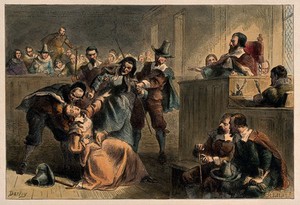
LYDIA BUSHROD CHEESMAN
LYDIA BUSHROD CHEESMAN

Lydia was a Farley. The Farleys were Quakers and anti-government. Her uncle was Captain George Farley. More about him, later. Her mother, Elizabeth, George’s sister, was widowed before Lydia was of marriageable age, and she remarried Thomas Bushrod, a recent widower. This Mr. Bushrod was a Quaker, which was illegal at the time. He had continually gotten into some trouble by his confession of beliefs in both Massachusetts, as a young man, and in Virginia. At the same time, he was a justice for York County as well as a burgess in 1658 and 1659. He had been married before to Mary Peirsey Hill, the sister-in-law of the notorious Governor, John Harvey.
Lydia was born around 1649. Her mother remarried in 1661 and they moved to the large plantation in York County that Bushrod had inherited from his dead wife. With Bushrod’s political ties, Lydia soon found a suitor who was acceptable. She was married within a few years to Edmund Cheesman. Edmund’s family had gotten into serious trouble when he was young, being arrested for having Quaker meetings at their house. Even his mother had been arrested. It would appear that Lydia was brought up as being sympathetic to Quaker religious thoughts.
The two married around 1670 and Edmund began building his legacy by patenting 200 acres in Charles Parish, York County on July 1, 1670. Within weeks he became a justice of the peace. In two years, he was a captain of the militia in York. During this time, Lydia and Edmund had a son, John, who died at a very early age. They had no further children. Four years later, Edmund was promoted to major. At that point, Nathaniel Bacon, a brash young immigrant, virtually declared war on the Virginia government. Not only did Edmund agree with Bacon, he joined his side. His contemporaries saw Cheesman as being a principal actor in the hostilities. His father had marched against the Pamunkey Indians in 1644, and Cheesman may have embraced Bacon’s plans to make war on Virginia’s Indians. It also appears that Lydia agreed with, or even encouraged, his actions.
This is where Lydia’s uncle George appears. George was sent to England for his education as a young boy. The rise of Cromwell coincided with George finishing his education and he joined the rebellion on the side of Cromwell. Once the king returned to power, George returned to Virginia. Apparently, fighting was in George’s blood, for he joined Bacon’s rebels around the same time as his nephew-in-law.
In November of 1676, Edmund was captured in York and accused of treason. George was captured and accused about the same time. Governor William Berkeley came for the preliminary trial. Lydia managed to sneak into the hearings and eventually was able to speak. and she pleaded with the governor to spare her husband’s life on the grounds that “if he had not bin influencd by her instigations, he had never don that which he had don.” On “her bended knees” she begged the governor “that shee might be hang’d, and he pardon’d.” Her eloquence and bravery failed to persuade the governor to release or spare him. Nor was she able to persuade him on any grounds to save her uncle. Before the trial date, Edmund died in prison, whether of sickness or exposure or grief, we will never know. She must have been quite a woman to even propose such a thought!
Two months later, George was executed in Accomac County and all his estates were forfeited to the king, or, perhaps, to the governor. His son, John, never got his family’s land back, since he, too, participated in the rebellion and was in prison at the time of his father’s execution.
In February, Governor Berkeley issued a proclamation of pardon for the treasonous actions of three men who, by coincidence, just happened to all die in prison over the winter. Edmund was one. Within three months, Governor Berkeley, having gone to London to report to the king, was dead.
A year later, Lydia claimed the estate of Edmund. It was probably held for some time after the trial. The estate consisted of 250 acres, six laborers, five black and one white, livestock and household furnishings. In June of 1678, the widow Lydia Cheesman married Thomas Harwood. She and her new husband occupied the land until her death. She died in the spring of 1694 by lightening. She was not yet 50.
After her death, Lydia’s brother-in-law, Thomas Cheesman, tried for years to gain the estate, eventually winning after the death of Harwood.

Recent Comments